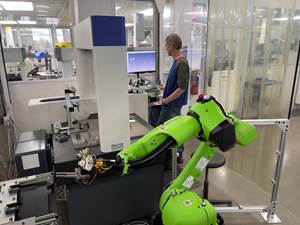The Difference between MTConnect and OPC UA
While OPC UA and MTConnect are both http-based protocols, there are differences between them, and each is best used in differing scenarios.
Although OPC UA and MTConnect are both http-based protocols (which makes them usable on internet-enabled networks), the question why MTConnect exists often arises since OPC UA has been around for a while and has wide support throughout industry. While similar in some regards, they are distinctly different in structure and purpose. Each has its advantages and disadvantages. Likewise, the scenarios in which they should be used are not the same.
MTConnect is described as a set of open, royalty-free standards intended to foster greater interoperability among machines, devices, control systems and software applications. It is a standard developed to translate machine tool data into a common, internet-based language interpretable by software applications. OPC UA is so named because the Open Platform Communications (OPC) organization designated its protocol for industrial communication as the Unified Architecture (UA). It is easier simply to understand it as the open, nonproprietary set of specifications that ensures that automation systems are compatible with one another. We can say that OPC UA is a standard that deals with making data available, while MTConnect is a standard that deals with making data actionable.
If we view machine monitoring at a high level, it’s apparent that MTConnect is best-suited for equipment with standardized functions, such as CNC controls or other equipment that has known capability. OPC UA is generally best-suited for one-off integration projects that use programmable logic controllers (PLCs). Another difference is that OPC UA can be a read-write protocol, whereas MTConnect is read-only. Nothing can be written back to the machine.
The primary difference between these standards is that MTConnect provides a standard dictionary of data items. The advantage is that the vocabulary is consistent across all equipment, regardless of which machine tool builder is involved. For example, by looking at “execution,” an MTConnect data item, the state of the machine can be readily known, no matter what type of machine generates data with this label. This consistency makes it easy for machine-monitoring software to show which machines on a network are running or not running.
MTConnect provides consistency in the meaning of data terms.
In comparison, OPC UA does not have a standard dictionary. When using OPC UA, it is necessary to know the address (or addresses) within the PLC where the running state (the equivalent to “execution”) is stored. This data location is likely to vary across different types of equipment. The end user will need to do some research to find where it is, and may need to process the data to derive the desired result. This makes it more difficult for software to report whether the machines or devices are running.
Yet OPC UA has its advantages. Although MTConnect is extensible (that is, more terms can be defined and added to its dictionary), the user is usually limited to the data items given in the MTConnect standard. The range of data available through OPC UA is greater because it is not constrained by a dictionary of available terms.
A driver is needed for OPC UA to retrieve data from the PLC. This driver is a software utility written specifically for this purpose to be used on a specific device. OPC UA drivers are readily available for many PLCs from a variety of vendors. In contrast, MTConnect requires someone to develop the MTConnect adapter, which is the software that collects the data from the machine and formats it for the MTConnect agent. The MTConnect agent, in turn, enables the data to be accessed by analysis and reporting software. MTConnect adapters may not be available for many types of machine tools or CNCs. (It should be noted here that, in some cases, OPC UA has been used to acquire data, which can then be provided to an MTConnect adapter for standard formatting.)
If MTConnect is available in the equipment to be monitored, it is generally the best option for this shopfloor application by virtue of its standard terminology. Significantly, the organizations that oversee MTConnect and OPC UA have worked together to make these standards compatible. This step ensures that, as the industrial internet takes shape, no machine or automated system will be left behind.
Related Content
Reinventing a Precision Shop With a Data-Driven Mindset
When this machine shop lost 90% of its business within three months, a reinvention was in order. Here's how it survived after quickly falling on hard times.
Read MoreBeyond the Machines: How Quality Control Software Is Automating Measurement & Inspection
A high-precision shop producing medical and aerospace parts was about to lose its quality management system. When it found a replacement, it also found a partner that helped the shop bring a new level of automation to its inspection process.
Read MoreSwiss-Type Control Uses CNC Data to Improve Efficiency
Advanced controls for Swiss-type CNC lathes uses machine data to prevent tool collisions, saving setup time and scrap costs.
Read MoreMachine Monitoring Boosts Aerospace Manufacturer's Utilization
Once it had a bird’s eye view of various data points across its shops, this aerospace manufacturer raised its utilization by 27% in nine months.
Read MoreRead Next
The Cut Scene: The Finer Details of Large-Format Machining
Small details and features can have an outsized impact on large parts, such as Barbco’s collapsible utility drill head.
Read More3 Mistakes That Cause CNC Programs to Fail
Despite enhancements to manufacturing technology, there are still issues today that can cause programs to fail. These failures can cause lost time, scrapped parts, damaged machines and even injured operators.
Read More














.png;maxWidth=300;quality=90)







